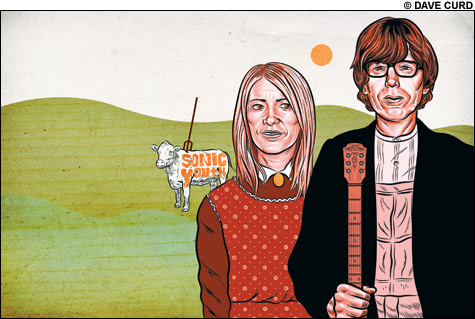 |
Honorable Mentions: Here are 25 other albums that helped bring the underground out of the basement
Bad Brains, Rock for Light (Caroline, 1983)
Big Black, Atomizer (Touch & Go, 1986)
Butthole Surfers, Rembrandt Pussyhorse (Latino Bugger Veil, 1986)
Nick Cave and the Bad Seeds, From Her to Eternity (Mute/Elektra, 1984)
Cocteau Twins, Treasure (4AD, 1984)
The Cure, The Head on the Door (Elektra, 1985)
Descendents, Milo Goes to College (SST, 1982)
Dream Syndicate, The Days of Wine and Roses (Slash, 1982)
The Fall, This Nation’s Saving Grace (Beggars Banquet, 1985)
Flipper, Generic Flipper (Subterranean, 1982)
Government Issue, You (Giant, 1987)
Gun Club, Fire of Love (Ruby, 1981)
Meat Puppets, Meat Puppets II (SST, 1984)
Melvins, Gluey Porch Treatments (Boner, 1987)
Minor Threat, Out of Step (Dischord, 1983)
Mission of Burma, Vs. (Ace of Hearts, 1982)
Moving Targets, Burning Acid (Taang!, 1986)
Naked Raygun, All Rise (Homestead, 1986)
Rites of Spring, Rites of Spring (Dischord, 1985)
Soul Asylum, Made to Be Broken (Twin/Tone, 1986)
Squirrel Bait, Squirrel Bait (Homestead, 1985)
Swans, Children of God (Caroline, 1987)
Throwing Muses, Throwing Muses (4AD, 1986)
Wipers, Youth of America (Park Avenue, 1981)
X, Wild Gift (Slash, 1981) |
They were, by definition, misfits. They were artists who truly could not be pigeonholed by the schlockmeisters pushing Styx and REO-Speedwagon product like used-car salesmen, because their music was unlike anything that came before.When alternative rock was a genre yet to be coined, when underground was truly subterranean, while MTV beckoned with piles of cash, these artists blazed new trails, created new paradigms, and ignored commercial prospects.
They were a handful of inspired mavericks who created the raw materials for an alternative future.
The setting for all this was the 1980s, a decade in which the demographic fragmentation following the punk rebellion took hold, leaving a great cultural and commercial chasm between the underground and just about everything else.
Of course, it wasn’t all as serious as that may sound. The bands and artists who made a difference in the ’80s weren’t afraid to poke fun at themselves and others, or, at times, to be sophomoric idiots. It’s no accident that so many of them, tongues firmly in cheek, covered classics they’d grown up on, recasting songs like Kiss’s “Black Diamond” (the Replacements) and Peter Frampton’s “Show Me the Way” (Dinosaur Jr.) as sources of genuine inspiration, even as they took the piss.
Ultimately, the inmates took over the asylum. Alternative rock found a place in the mainstream, and indie labels like Sub Pop, Matador, Merge, and Epitaph became training grounds for commercial success. We know that now. But before 1991 and the Nirvana juggernaut, none of that was clear.
One of the albums that embodied the spirit of the ’80s hodgepodge movement, Sonic Youth’s 1988 double-LP Daydream Nation, has over the past year finally started to receive the attention it was always due. In 2006, the Library of Congress honored the disc by placing it in the National Recording Registry. This year, Daydream Nation was re-released as a deluxe two-CD set, and Sonic Youth are celebrating by playing the entire album live, start to finish, in a US tour that begins this weekend.
With that in mind, we’ve reopened the vaults and gone back to Daydream Nation and nine other seminal albums from the ’80s underground. The parameters are narrow. The 10 albums we’ve chosen are part of a narrative that’s cohered over time — a narrative inspired by the increasing acceptance of Daydream Nation as part of the larger rock canon. (A parallel tale that deserves its own chapter, of course, is the rise of hip-hop.)
These are the 10 albums that generated the right conditions for the rock that would follow. But they weren’t mere stepping stones. Each has its own story, suggesting other albums and artists that have a place somewhere in the rock pantheon. As Sonic Youth guitarist Lee Ranaldo explains in the 33-1/3 book devoted to Daydream Nation, “We were learning from and being inspired by bands from around the country in this really cool, secret indie world that the mainstream media still doesn’t know anything about. What was really happening in the ’80s — no one has captured any of it. What happened on MTV and what happened in the clubs was totally different. Everyone was drawing from the Velvet Underground and Captain Beefheart and Iggy and the Stooges and Television. . . . That part is lost so far.” This is our effort to find it.
VIDEO: Sonic Youth, "Teenage Riot"
Sonic Youth, Daydream Nation (Enigma, 1988)
Two decades ago, the very idea that a band like Sonic Youth, with their taste for feedback-laced dissonance, post-modernist deconstruction, no-wave nihilism, and noise, noise, noise, could have any impact beyond the confines of the small world in which Amerindie post-punk existed was simply preposterous.
And when the pre-grunge grungy New Yorkers released Daydream Nation in 1988, the Earth did not stop revolving around the sun.